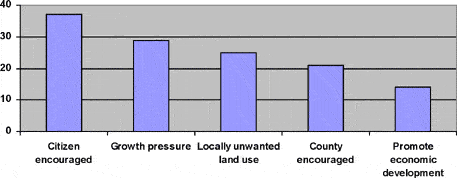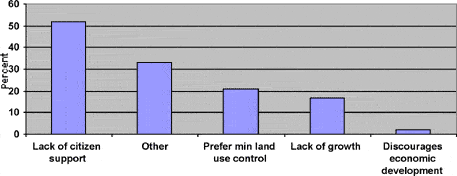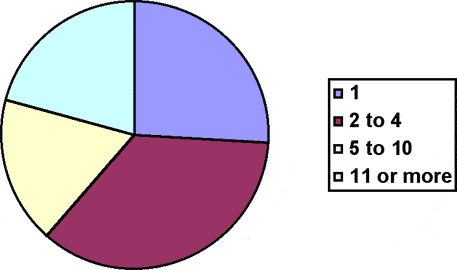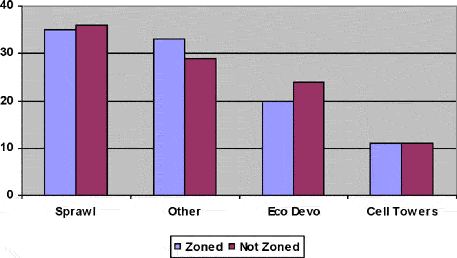August 2006 // Volume 44 // Number 4 // Research in Brief // 4RIB5
Land Use Planning and Zoning in Ohio Townships
Abstract
The study reported here examined the
use of zoning for growth management in Ohio townships. Data were obtained
from a survey of 252 township officials. The results showed that 59% of townships
are using zoning, primarily due to citizen support. Zoned townships are using
a variety of zoning techniques to assist in managing land use change and
growth. Those townships without zoning cite a lack of growth and citizen
interest as reasons for not using zoning.
In many areas of the county, including Ohio, rural communities are experiencing rapid growth. Nationally, more people live in unincorporated areas than live in municipalities, villages, and other incorporated areas (Kraybill & Lobao, 2001). In Ohio, more people now live in unincorporated townships than in cities with a population of 50,000 or more. Three million people lived in unincorporated townships in 1970, by 2000 this figure increased to 3.9 million. At the same time population in unincorporated areas has increased, land area has decreased due to annexation (Clark, Sharp, & Irwin, 2003).
Rural planning agencies are increasingly being called upon to make land use decisions. Arnold (2000) proposed that planning assistance is an important component of rural research and outreach. However, at the present time there is limited research on how rural planning agencies make land use decisions. This information is becoming more essential as Ohio, like many other states, is experiencing rapid growth in rural areas.
Although Ohio's townships face escalating growth, it is difficult for counties and townships to effectively manage growth because they rely primarily on volunteers serving on land use boards and commissions (Arnold, 2000). In Ohio, this is further complicated by the state's unique governance structure; while in most states the county is responsible for planning and land use management in the unincorporated areas, in Ohio this responsibility falls to townships with the assistance of counties.
Given the growth and development pressures in townships, coupled with the limited administrative capacity and fragmented governance structures, more information is needed about how these unincorporated areas are managing land use. This article examines the state of rural land use management in Ohio's townships by presenting results of a statewide survey of current land use and zoning practices.
Land Use Management in Ohio
While counties have a role in land use planning, the 1,309 townships in Ohio have the authority to determine their own level of land use planning. Ohio townships are generally small in size and have limited administrative capacity to engage in land use planning (Table 1).
|
Population |
Number of Townships |
Percentage of Townships |
|
< 1,000 |
350 |
26.7 % |
|
1,000-4,999 |
805 |
61.5 % |
|
5,000-9,999 |
99 |
7.6 % |
|
10,000-24,999 |
38 |
2.9 % |
|
25,000-49,999 |
14 |
1.1 % |
|
> 50,000 |
3 |
0.2 % |
|
Total |
1,309 |
100 % |
Townships can participate in any of the following:
- Township Zoning;
- County-wide Zoning; or
- No Zoning (ORC, 1953).
In 1997, approximately half of Ohio townships used zoning (Pritchard & Stamm, 1998). By 2003, this had increased to 59%, based on research by the authors.
Methodology
The Ohio Township Association partnered with the Ohio State University Extension Community Development Office in 2003 to conduct a survey of townships that asked a series of questions related to township administration. As of December 2003, 824 of the 1,309 townships (63%) had responded to the survey. Fifty-four percent of responding townships indicated that they had zoning, while 46% responded that they did not.
A second survey was designed to ask more specific questions about land use management in townships. The surveys, sponsored by the Ohio Township Association and the Ohio State University, were mailed to a random and geographically distributed sample of townships that responded to the first survey. A follow-up survey was mailed to the non-respondents approximately 3 weeks after the first mailing. As a result of two mailings, responses were received from 82 of the 186 townships without zoning (44%), and 170 of the 250 townships with zoning (68%).
Results
Adoption of Zoning
An important factor in understanding local land use management includes determining the motivations behind adopting zoning. The majority of townships identified encouragement or support from others as one of their primary motivations for adopting zoning (Figure 1). Townships also recognized growth pressures, locally unwanted land uses (LULU), and the possibility of promoting economic development. Other reasons included adoption to address problems with manufactured housing, to keep the township agriculturally friendly, and to conserve and protect property values.
Figure 1.
Reasons for Adoption of
Zoning

Nearly half (46%) of responding Ohio townships did not have zoning. This represents a considerable portion of townships that may be making local land use decisions outside of zoning. Information was collected about whether these townships have considered adopting a zoning resolution. Townships zoning is the responsibility of the township trustees. A township can choose to enact zoning on the basis of a majority vote by residents. Of the responding townships, 34% have considered the adoption of zoning.
The primary reason that townships had not adopted zoning was a lack of citizen support (Figure 2). Additional reasons included small township population, too rural, primarily a farming area, zoning would reduce economic development, and the cost of implementing zoning.
Figure 2.
Reasons for Not Adopting
Zoning

While citizen support was the primary reason for zoning adoption in townships, lack of citizen support was identified by townships without zoning as the primary reason for not adopting it. This consistency points to the clear importance of citizen and county support for land use policies to manage growth. It highlights the need both for citizen education on the importance and implications of land use management and for a stronger role of the county or other regional governments in supporting township efforts in growth management--support that could come from more communication and intergovernmental cooperation.
Land Use Planning Efforts
Before adopting zoning, townships should develop comprehensive plans that are designed to guide the future of their communities and serve as the basis for zoning regulations. Our data shows that approximately 70% of surveyed townships with zoning had some form of a comprehensive plan in place, either their own or their county's, with future growth goals upon which to base their zoning regulations.
Figure 3.
Type of Comprehensive Plan
Adopted by Townships

The population of a township is related to whether it has a comprehensive plan. Townships without comprehensive plans had an average population of 3,622, with only two of the townships having a population greater than 5,000. Townships with a comprehensive plan had an average population of 7,312, with 35% having a population of 5,000 or more. Although Ohio law does not require that a comprehensive plan be in place, it is good planning practice to have one. The respondents reported the average year for plan revisions was 2001. Therefore, those townships that have adopted comprehensive plans have kept them up to date.
Although townships without zoning noted that they have serious land use issues facing their communities, planning as a whole appeared to be a low priority in these townships. Only seven of the 82 responding townships without zoning (8.5%) had a comprehensive land use plan. This is alarming from a land use management perspective because the comprehensive plan is considered the basis of land use planning, and it can be used to prioritize community land use goals in townships without zoning regulations.
Growth Management Challenges and Issues
Stability of Zoning Resolutions
While many of the surveyed townships had zoning in place, the stability of zoning was not always set in stone. Of the 170 responding townships with zoning:
-
7% had an attempted repeal initiated by voters. and
-
22% have had their zoning resolution challenged in court (all but five had their zoning resolutions upheld).
Another threat to the stability of zoning resolutions is made when land use plans are compromised by rezoning approvals. The number of rezoning applications in an area acts as a good indicator for the growth pressures in the township (Diaz & Green, 2001). Sixty-one percent of townships received a rezoning application in the last year (Figure 4).
Figure 4.
Number of Rezoning Applications
Reviewed in the Last Year

A total of 371 rezoning applications were reviewed in the last year among responding townships. Of those, 208 applications (56%) were approved. The majority of rezoning applications requested a change in land use from an agricultural district to a residential district--25 townships reviewed 64 rezoning applications for this change. This is a common request that many rural local governments across the nation are likely encountering in response to increasing population growth.
The impact of increased growth on townships highlights the concern for the permanency of zoning regulations. While zoning repeals and challenges reflect direct and obvious implications for land use management, rezoning can affect the effectiveness of growth management approaches in a more elusive fashion. Rezoning decisions that deviate from a community's land use plan can quickly weaken the effectiveness of growth management goals. More stability can be brought to zoning resolutions by garnering citizen support and making longer-range decisions when it comes to rezoning requests.
Administrative Capacity Challenges
When townships with zoning were surveyed about their greatest challenges in administering zoning, the most frequent challenges fell within a category of administrative capacity (Table 2).
|
Zoning Enforcement |
60% |
|
Lack of Understanding on the Part of Property Owners |
52% |
|
Unhappy Property Owners |
30% |
|
Variances |
17% |
|
Amount of Paperwork |
14% |
Most townships (60%) identified zoning resolution enforcement as their greatest challenge. This may be in part because a majority of the responding townships (59%) have part-time instead of full-time zoning inspectors who are responsible for reviewing zoning applications, enforcing zoning, and handling requests for information about zoning from property owners. Townships with part-time zoning inspectors have an average population of 2,552. By contrast, the average population for townships with full-time zoning inspectors is 7,463, which again highlights the correlation between population and administrative capacity limitations in local governments.
Land Use Management Issues
Townships were asked about the greatest land use issue facing them (Figure 5). Rural sprawl was identified as the most prominent land use issue confronting both townships with (35%) and without zoning (36%). Rural sprawl has become a common factor in communities across the nation's rural areas, and all are struggling to address it. Given the rates of urbanization in Ohio and the townships growth rates, it is not surprising that issues characteristic of sprawl, such as uncoordinated growth and land consumption, are of key concern to townships. Other issues include factory farms, landfills, coal mining, and manufactured housing.
Figure 5.
Major Land Use Issues

Land Use Tools to Protect Rural Character
Until recently, townships have been limited in their ability to adopt innovative tools to manage growth, including those that help preserve rural character. The preservation of rural character is of significant importance to the vast majority of townships. Township officials were asked about the types of zoning tools they use to protect rural character and, based on the survey data, Ohio townships are primarily using agricultural zoning, conservation zoning, and planned unit developments to protect rural lands (Table 3).
|
Tool |
Adopted (%) |
Considered Adoption (%) |
|
Agricultural Zoning |
26 |
31 |
|
Conservation Zoning |
21 |
22 |
|
Planned Unit Development |
41 |
17 |
|
Transfer of Development Rights |
0 |
35 |
Agricultural zoning is one of the most common methods for preventing the conversion of agricultural land to nonagricultural uses. This zoning technique can prohibit all uses except for agriculture or allow a limited amount of nonagricultural development. Conservation zoning, also known as "cluster zoning" or "open space zoning," is designed to protect open land while allowing for new development. Many townships use Planned Unit Developments (PUDs) as a form of conservation zoning. Another zoning tool available to townships is transfer of development rights (TDR). TDR programs can provide an organized way to preserve farmland by transferring potential development from prime agricultural areas to areas that are more suitable for development. While a number of townships are using tools to preserve character, the majority have not adopted these tools.
Conclusions and Policy Recommendations
Due to an increasing number of people choosing to live in Ohio townships and the resulting land use changes that come with growth, more attention should be paid to township level land use management. Many of Ohio's townships are using zoning as a tool to help shape land use change. Zoning can manage growth and offer protection from rural sprawl and locally undesirable land uses. While planning policies fighting rural sprawl have received attention in the United States and in Ohio, results suggest that the development of planning policies by townships is a difficult process that is plagued by a lack of administrative capacity and, in many cases, public support.
The results of the study reported here suggest that citizen support is the primary reason for zoning adoption in townships with and without zoning. Townships have adopted or considered several zoning techniques, such as agricultural zoning, conservation zoning, PUDs, and TDRs. These findings suggest that more attention should be given to outreach programs that can help educate citizens about zoning. Extension agents may play an important role in this effort, as they can point to zoning and other planning efforts as a solution to common concerns such as LULUs and sprawl. In addition, Ohio townships use fundamental land use tools such as the comprehensive plan.
The goal of managing growth through zoning is not solely the responsibility of townships. They should be encouraged to coordinate with counties, regional planning commissions, and Extension on land use issues as a way to address administrative capacity and effective zoning implementation issues. McLeod, Coupal, and Seidl (2003) found that engaging community leaders is critical in addressing land use issues. Regional planning commissions in coordination with extension should provide training for township officials on land use management issues, which Seidl (2001) notes is an appropriate role for Extension.
Acknowledgements
This research was funded by the Center for Urban and Regional Analysis at Ohio State University. Support for this research was also provided by the Ohio Township Association and Ohio State University Extension.
References
Arnold, C. (2000). Land use is the issue, but is land grant the answer? Journal of Extension [On-line], 38(6). Available at: http://www.joe.org/joe/2000december/comm1.html
Clark, J., Sharp, J. S., Irwin, E., & Libby, L.. (2003) Growth and change at the rural-urban interface: An overview of Ohio's changing population and land use. Retrieved April 18, 2004 from The Exurban Change Project at Ohio State University: http://www-agecon.ag.ohio-state.edu/programs/exurbs/growthandchange/growth%20change%20-%20no%20graphics.pdf
Diaz, D. & Green, G. P.. (2001). Growth management and agriculture: An examination of local efforts to manage growth and preserve farmland in Wisconsin cities, villages, and towns. Rural Sociology. 66(3), 317-341.
Kraybill, D. & Lobao, L.. (2001). County government survey: Changes and challenges for the new millennium. Washington, DC.: National Association of Counties.
McLeod, D., Coupal, R., & Seidl, A. (2003). Opportunities and challenges for land use planning in the Intermountain West. Journal of Extension [On-line], 41(5). Available at: http://www.joe.org/joe/2003october/a5.shtml
Ohio Revised Code. (1953) Chapter 519. Retrieved July 9, 2004: http://onlinedocs.andersonpublishing.com/oh
Prichard, T. & Stamm, J.. (1998). Ohio rural zoning. OSU Extension Poster. Columbus, Ohio: The Ohio State University Extension.
Seidl, A. (2001). Colorado professionals' concerns, abilities and needs for land use planning. Journal of Extension [On-line], 39(4). Available at: http://www.joe.org/joe/2001august/rb5.html
